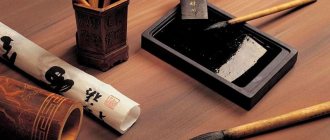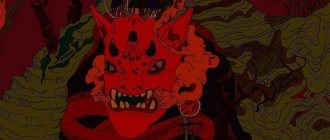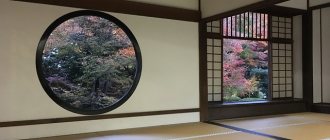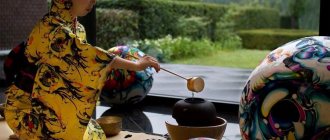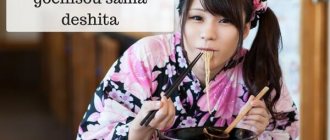During the “move” from Japan to Russia, the nesting doll changed gender and religion. One thing has remained unchanged - many small replicas inside. Interestingly, in Japan this “nesting” has a completely different meaning.
The matryoshka is considered a symbol of Russia, but the toy has Japanese roots. How is the toy connected with the land of the rising sun and what forces were controlled by its “father” - the powerful deity Fukuruma?
Who invented the matryoshka doll?
The Russian nesting doll was “born” at the end of the 19th century thanks to Sergei Malyutin. The artist, in love with Russian art, spotted an interesting concept from Japanese masters - a toy consisting of eight copies. Malyutin Russified the idea. So, the Japanese elder was replaced by a portly young lady with rosy cheeks. A few years later, the toy was turned out by the talented turner Sergei Zvezdochkin based on Malyutin’s sketches.
Malyutin didn’t just turn a nesting doll into a woman. The first toys did not include eight identical copies, but children - boys and girls with different appearances. The last, non-demountable part is a baby in diapers. Thus, the first nesting doll was the mother of a large family. Hence the name. Matryona is a common female name at that time, which comes from the word “mother”.
Father of Zen Buddhism
But the doll called Daruma has its own amazing story. Daruma is the Japanese shortened pronunciation of the name Bodhidharma, the founder of the Zen Buddhist school. In the 510s, Bodhidharma went to China, where he founded the well-known Shaolin Monastery in the Sunshan Mountains. In this monastery, according to legend, for nine years Bodhidharma indulged in meditation, contemplating the wall. He died in 528, having passed on the sacred teachings of Zen to his students. In Japan, the teachings of Zen Buddhism, as well as the founder of this teaching, became popular from the middle of the 12th century. Daruma himself was usually depicted as a doll with bulging eyes, without arms or legs, which was supposed to hint at the nine-year meditation of the patriarch, during which, according to legend, his limbs atrophied. Over time, the appearance of the doll changed, and 200 years ago it was finally formed. The modern Daruma doll looks and behaves almost like our tumbler doll. Only instead of a childish face, Daruma has thick eyebrows and the beard of the wise father of all Zen Buddhists. It is interesting that Daruma does not have pupils, but this feature will be discussed below. According to tradition, Daruma is painted red to match the robes of a priest, but there are dolls in both yellow and green. Less known, but no less attractive, are other variants of this type of toy, created in different regions of Japan: Matsukawa Daruma (in the form of a samurai with thick eyebrows), Onna Daruma (in the form of a woman), Hime Daruma (a princess girl), Sumi Daruma (from piece of charcoal), Sankaku Daruma (conical shape).
Japanese god of luck
The prototype of the matryoshka had a beard. The ancient elder Fukuruma is a revered deity in Japan. The good sage is part of the pantheon of seven gods who are responsible for luck, happiness and prosperity. Fukuruma's appearance is specific: an oval body-head, slightly elongated at the top, decorated with a beard and small cunning eyes. Eight copies inside - eight human bodies. The ancient sages believed that each person has several “shells”.
Malyutin saw a cute figurine of Fukuruma, or, as he is called in Japan, Fukurokuja, at the end of the 19th century. However, there is another version about what really inspired the artist. Matryoshka Daruma is not such a pleasant parent.
Japanese Daruma
This is a simple-looking toy, round like a bun, has the properties of a tumbler and... works wonders. Well, that’s what is commonly believed, at least))) And for a miracle, all you need to do on New Year’s is make a wish and draw one eye for her. And when your wish comes true, don’t forget to draw a second one, otherwise the magic won’t work anymore.
Daruma is a shortened Japanese name for Bodaidaruma, Bodhidharma, the founder of the Zen school of Buddhism in the 5th and 6th centuries.
According to legend, after meditating for 9 years, Bodaidaruma wanted to get up, but fell, as his limbs and muscles atrophied. Well, here is the doll - without arms, without legs, falls, but rises again. And for these reasons, the Daruma doll, as you already understand, symbolizes perseverance and determination. Next to the doll you can see the following slogan: nanakorobi yaoki 七転八起 - fell seven times, rose eight. This phrase is symbolic, since every time a person rises after a fall, he strives to become better. Well, in reality, for example, during the Edo period, when the tradition came to associate the fulfillment of one’s desires with the acquisition of a doll, there were many outbreaks of smallpox and measles. And according to legend, if a child fell ill in the house, it was necessary to stretch ropes around the house with red paper strips strung on it, dress the child in a red robe and make a small altar for God and put a talisman there - Daruma. The figure was used to appease God and encourage the sick person to recover quickly.
As a rule, Daruma is made of wood or papier-mâché. The choice of material is determined by the fact that it is customary to burn dolls if a wish is not fulfilled. This is done in the temple according to a special ritual. All Daruma dolls that have not been granted a wish in the current year are brought to the temple (once a year) for a traditional burning ceremony called Daruma Kuyo, which takes place in the first days after the New Year.
Having expressed his gratitude to Daruma, the owner gives it to the temple and after 24 hours of reading sutras, a festival procession of children, and a solemn performance by monks, tens of thousands of Daruma figurines are set on fire.
Daruma's face carries a certain meaning and interpretation: the beard is made in the shape of a turtle, which lives for 10,000 years and symbolizes longevity; on the sides and belly of the doll there are other spells - for good luck, good business and long family relationships.
Traditionally, the Daruma doll is made in red, but other colors can be seen. So, for example, if you make a wish for love, you can buy a pink doll, wealth and money - yellow, health - green, there is also a golden Daruma doll, which brings good luck in financial matters. The white doll is a talisman in the silk industry and healthy child rearing, popular in Daruma in Yamanashi Prefecture.
As soon as Daruma falls into your hands, you should do the following:
Step 1 – Determine the specific goal you intend to achieve.
Step 2 - Paint over one of the eyes (it doesn't matter whether it's left or right) to show your desire to achieve your goal.
Step 3 - Place the doll in a prominent place in the house so that while Daruma is focusing on your goal, you will not stop thinking about it and going towards it.
Step 4 – once the goal is achieved (and this is exactly what it will be), complete Daruma’s second eye, this way you say “Thank you!” to her!
Step 5 – Write the achieved goal on Daruma's back.
What's next? And then you need to buy a new Daruma doll, preferably a larger one, and fulfill your next wish!)
Keep in mind that success comes only with clear and correct goal setting!
The key to success is a clear vision of what you want, focus on results and determination that will not allow you to deviate from your plans. Daruma is the embodiment of your specific goal. And at the same time, the doll is a reminder that once you have set out on the road to achieving your goal, you will never turn back! The wishes made must be measurable, that is, have a deadline for fulfillment. The ideal period for fulfilling a wish is 1 year. For Daruma to work, you need to remember the following: you can purchase a doll only once a year and, accordingly, make only one wish; Having bought a doll, you need to draw one eye for it; the desire should not seem impossible or immodest; it is better to take small steps to achieve great success; if the wish does not come true, the doll is burned in the temple where it was purchased; for this, the temple seal is placed on the dolls. In general, if the temple seal is not in place, then your Daruma will not work)
In Japan, there is an adult approach to dolls. For example, Daruma is widely used by politicians who have started an election campaign: they buy a Daruma doll, draw one eye on it, making a wish to win the elections, and finish drawing the second eye after the elections. But now this is not advertised, since this ritual was considered incorrect in relation to the blind.
The first mention of the use of a doll in an election campaign dates back to 1928. In 1930, in the city of Nagano, Mr. Matsumoto took Daruma as his assistant and, as a result, won the elections, this became the basis of today’s tradition among politicians. Today, 2.5 million figures are sold per year in Japan. More than 100 families in Takasaki continue the tradition of their ancestors by making Daruma dolls to sell at the fair. Not only Japanese, but also foreign tourists come to Takasaki to buy a doll. Materials from the sites ***https://tensaigakkou.ru/kukla-daruma-kak-zagadat-zhelanie/*** ***https://orient-gift.ru/interesnoe/22-osobennost-kukly-daruma were used. html***
See more collectible dolls in themes on Babyki.
Japanese Daruma doll
Daruma is neither a god nor a spirit. He is considered the founder of Zen Buddhism and a great sage. In order to achieve nirvana, he sat in front of a bare wall for eight years, meditating. Focused thoughts divided his essence into eight “shells”. Due to the fact that Daruma sat in one place for eight years, his legs became paralyzed. For this reason, all Darums are tumblers. The nesting doll also inherited the absence of legs.
Daruma doll
Intensified meditation did not only lead to the loss of legs. At some point, Daruma realized that he was not meditating, but dozing. Then he cut off his eyelids so that he would always be awake, and threw them on the ground. Subsequently, a wonderful invigorating drink - tea - grew from the eyelids.
The Daruma figurine is egg-shaped. The toy has neither legs nor arms. Most of the figure is a face with huge eyes. Mini-sages are not all the same. Each subsequent figure is painted simpler than the “shell”. The last element is a small ball with dotted eyes.
Japanese spirit
The demonology of the Land of the Rising Sun is a unique phenomenon. You cannot take a step here without bumping into some spirit or deity. The amount of Japanese evil spirits is perfectly demonstrated by the following legend. Many thousands of years ago, a certain spirit nicknamed Hakutaku - a creature with nine eyes and six horns - decided to leave the islands and travel the world. Once on the mainland, he was captured by Emperor Huang Di, the founder of Taoism and the ancestor of all Chinese. Hakutaku was a kind and harmless spirit, but the emperor agreed to release him only on the condition that he tell him in detail about all his fellow tribesmen - creatures from the invisible world. Haku-taku had no choice but to agree. They say that many days and nights have passed since the moment when the spirit began to tell stories about its fellows. Hundreds of scribes, replacing each other every few hours, wrote down his words. By the end of the story, Emperor Huang Di found himself in possession of a huge encyclopedia - a bestiary that contained details concerning 11,520 Japanese inhabitants of the other world. Unfortunately, this unique encyclopedia has not survived to this day.
